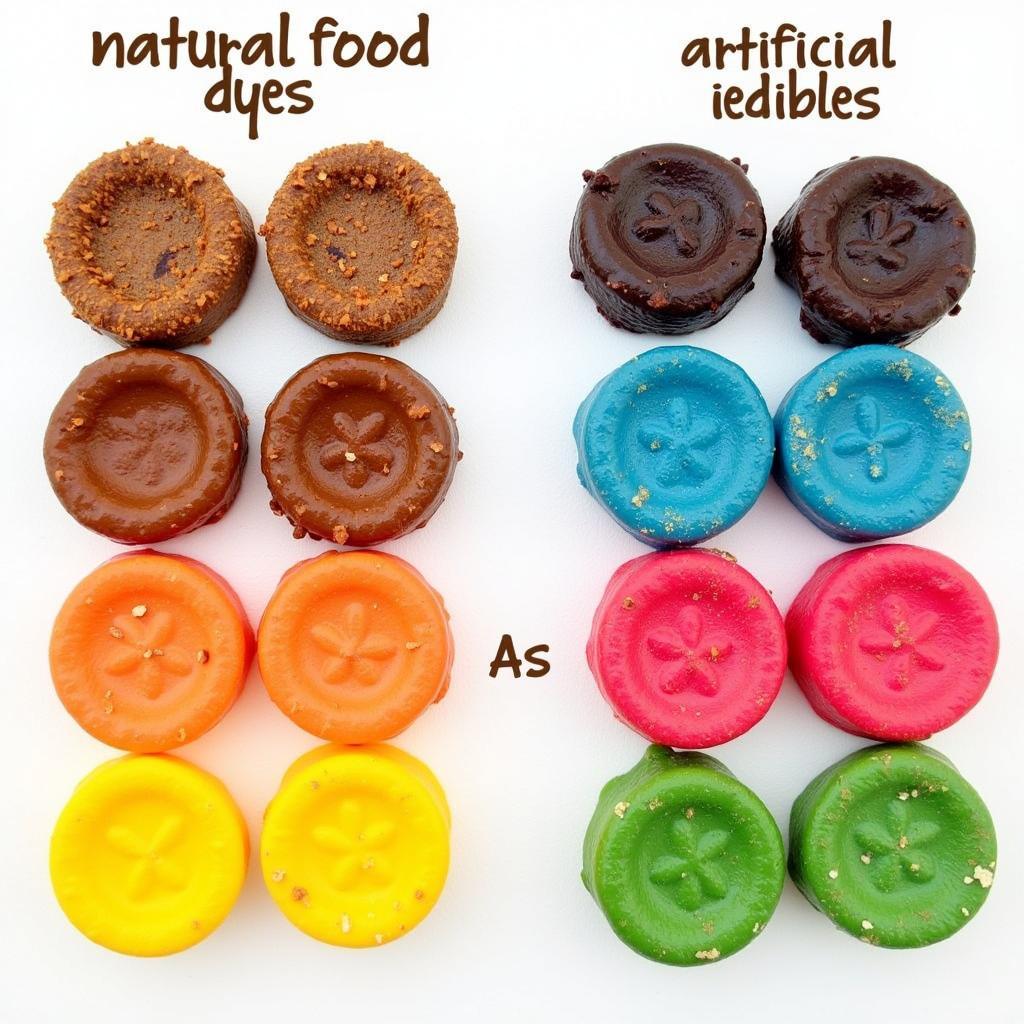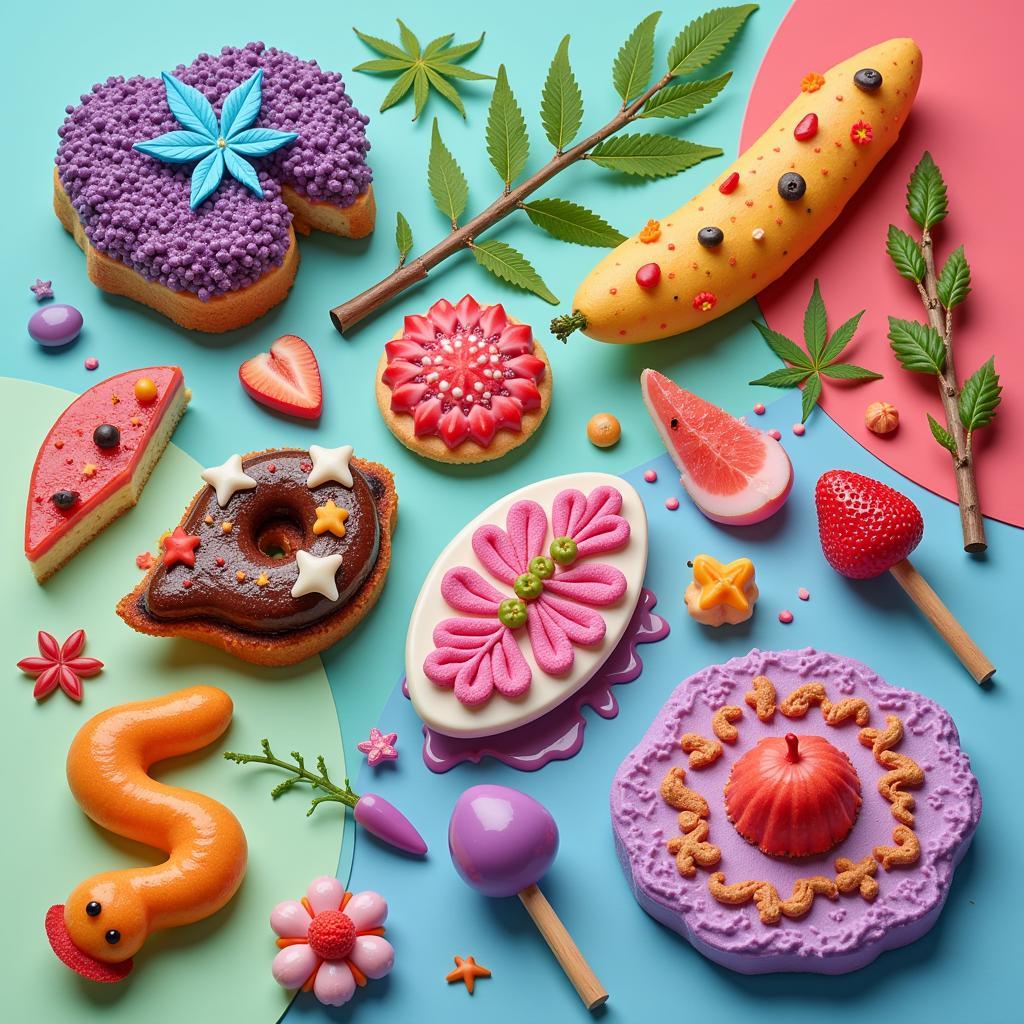Food Coloring In Weed edibles has become a topic of increasing interest, sparking curiosity among both recreational and medicinal cannabis users. While the primary purpose is often to enhance the visual appeal of products, there’s more to this practice than meets the eye. This article dives deep into the world of food coloring in cannabis edibles, exploring its benefits, safety considerations, and the potential implications for the future of the industry. Want to learn how to elevate your mermaid-themed food ideas? Check out our guide.
Why Use Food Coloring in Cannabis Edibles?
The vibrant colors of fruits and candies are often associated with delicious flavors and enjoyable experiences. Adding food coloring to cannabis edibles can evoke similar positive associations, making them more appealing to consumers. This is particularly important for products targeting specific demographics, such as those with a sweet tooth or those seeking a more visually stimulating experience.
Masking Unpleasant Colors and Enhancing Appearance
Cannabis concentrates, especially when incorporated into edibles, can sometimes have unappealing colors, ranging from murky greens and browns to dark, almost black hues. Food coloring allows manufacturers to mask these undesirable colors and create visually appealing products that are more enticing to consumers. This is crucial for creating a positive first impression and encouraging repeat purchases. Imagine bright green gummy bears or vibrant red lollipops – these colors are much more inviting than a dull, brownish paste.
 Vibrant Cannabis Gummies with Food Coloring
Vibrant Cannabis Gummies with Food Coloring
Branding and Product Differentiation
In a rapidly growing market, branding and product differentiation are essential for success. Food coloring can be a powerful tool for creating a unique brand identity and making products stand out on the shelves. By using specific color schemes and designs, companies can establish a recognizable brand aesthetic and appeal to specific target audiences. For instance, a company specializing in relaxing edibles might use calming shades of blue and green, while a brand focused on energizing products could opt for vibrant yellows and oranges.
Safety Considerations: Choosing the Right Food Coloring
While food coloring can enhance the appeal of cannabis edibles, it’s crucial to prioritize safety. Not all food colorings are created equal, and some may contain harmful ingredients.
Natural vs. Artificial Food Coloring
Natural food colorings are derived from plant-based sources like fruits, vegetables, and spices. While they are generally considered safer than artificial options, they may not offer the same vibrant hues or long-lasting color stability. Artificial food colorings, on the other hand, are synthetically produced and can achieve more intense colors. However, some artificial colorings have been linked to potential health concerns, so it’s essential to choose FDA-approved options and use them in moderation. Planning a Disney villain party? Check out our Disney villain party food ideas for inspiration.
 Natural vs. Artificial Food Coloring in Cannabis Edibles
Natural vs. Artificial Food Coloring in Cannabis Edibles
Dosage and Potential Allergens
Even with FDA-approved food colorings, it’s important to use them in appropriate dosages. Excessive consumption of certain food colorings may cause adverse reactions in some individuals. Additionally, some people may be allergic to specific food dyes, so it’s crucial for manufacturers to clearly label their products and provide detailed ingredient information.
The Future of Food Coloring in Weed
As the cannabis industry continues to evolve, the use of food coloring in edibles is likely to become even more sophisticated. Here are some potential trends to watch:
- Customized Colors and Designs: With advancements in printing technology, we may see more personalized edibles with custom colors and designs. Imagine edibles printed with your favorite sports team’s logo or a special message for a loved one.
- Color-Changing Edibles: Imagine edibles that change color based on temperature or pH levels, offering a unique sensory experience. This technology could also be used to indicate the potency or type of cannabinoid present in the edible.
Looking for unique green food options? Our guide on SP green food might inspire you!
Conclusion
Food coloring in weed edibles serves a purpose beyond mere aesthetics. It enhances visual appeal, aids in branding, and can even contribute to a more enjoyable consumption experience. However, it’s crucial to prioritize safety and choose high-quality, FDA-approved food colorings. As the industry matures, we can expect to see even more innovative and creative uses of food coloring in cannabis edibles. Always choose products from reputable brands that prioritize transparency and provide detailed ingredient information. Looking for more mermaid-themed food inspiration? Check out our Mermaid Theme Food Ideas.
FAQ
- Is food coloring in weed edibles safe?
Yes, as long as it’s FDA-approved and used in appropriate dosages. - What are the benefits of using food coloring in cannabis edibles?
It enhances visual appeal, masks unpleasant colors, and aids in branding. - What are the different types of food coloring used in weed edibles?
Natural and artificial food colorings. - Are there any potential risks associated with food coloring in edibles?
Some individuals may have allergies to specific food dyes. - What are the future trends in food coloring for cannabis edibles?
Customized colors, designs, and color-changing edibles. - Where can I find natto? Our guide on where to buy natto food might be helpful.
- What are some other fun food themes? Consider mermaid themed food ideas.
 The Future of Food Coloring in Cannabis Edibles
The Future of Food Coloring in Cannabis Edibles
Common Scenarios and Questions
Scenario: A parent is concerned about their teenager consuming brightly colored cannabis gummies.
Question: Are brightly colored edibles more appealing to children?
Answer: While brightly colored edibles can be visually appealing, responsible storage and education are crucial to prevent accidental ingestion by children. Packaging should be child-proof, and edibles should always be kept out of reach.
Scenario: A consumer is curious about the ingredients in their cannabis edibles.
Question: How can I tell if the food coloring used in my edibles is safe?
Answer: Check the product label for a list of ingredients. Look for FDA-approved food colorings and avoid products with unknown or potentially harmful dyes.
Further Exploration
- Explore more creative food ideas on our website.
- Learn more about cannabis edibles and their effects.
Need assistance? Contact us at Phone Number: 02437655121, Email: minacones@gmail.com or visit us at 3PGH+8R9, ĐT70A, thôn Trung, Bắc Từ Liêm, Hà Nội, Việt Nam. We have a 24/7 customer service team.